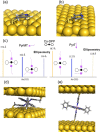Tuning Single-Molecule Conductance in Metalloporphyrin-Based Wires via Supramolecular Interactions
- PMID: 33448538
- PMCID: PMC7590179
- DOI: 10.1002/anie.202007237
Tuning Single-Molecule Conductance in Metalloporphyrin-Based Wires via Supramolecular Interactions
Abstract
Nature has developed supramolecular constructs to deliver outstanding charge-transport capabilities using metalloporphyrin-based supramolecular arrays. Herein we incorporate simple, naturally inspired supramolecular interactions via the axial complexation of metalloporphyrins into the formation of a single-molecule wire in a nanoscale gap. Small structural changes in the axial coordinating linkers result in dramatic changes in the transport properties of the metalloporphyrin-based wire. The increased flexibility of a pyridine-4-yl-methanethiol ligand due to an extra methyl group, as compared to a more rigid 4-pyridinethiol linker, allows the pyridine-4-yl-methanethiol ligand to adopt an unexpected highly conductive stacked structure between the two junction electrodes and the metalloporphyrin ring. DFT calculations reveal a molecular junction structure composed of a shifted stack of the two pyridinic linkers and the metalloporphyrin ring. In contrast, the more rigid 4-mercaptopyridine ligand presents a more classical lifted octahedral coordination of the metalloporphyrin metal center, leading to a longer electron pathway of lower conductance. This works opens to supramolecular electronics, a concept already exploited in natural organisms.
Keywords: biomolecular electronics; density functional calculations; metalloporphyrins; single-molecule junctions; supramolecular electronics.
© 2020 The Authors. Published by Wiley-VCH GmbH.
Conflict of interest statement
The authors declare no conflict of interest.
Figures






References
-
- Meijer E. W., Schenning A. P. H. J., Nature 2002, 419, 353–354. - PubMed
Publication types
LinkOut - more resources
Full Text Sources
Miscellaneous

